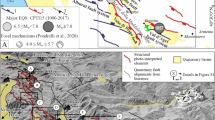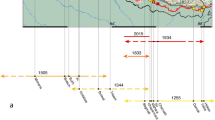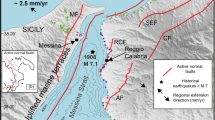Abstract
THE Great Glen Fault was shown by W. Q. Kennedy1 to be a sinistral tear fault on which a displacement of about 65 miles has occurred since Middle Old Red Sandstone time. E. M. Anderson1 considered that “the curvature of the fault trace may indicate that we are dealing with the south-western sector of a major fault and that the main extension of the dislocation will probably lie to the north-east”. This curvature is a gradual change of strike from about 040° in Loch Linnhe to about 035° at Inverness.
This is a preview of subscription content, access via your institution
Access options
Subscribe to this journal
Receive 51 print issues and online access
$199.00 per year
only $3.90 per issue
Buy this article
- Purchase on Springer Link
- Instant access to full article PDF
Prices may be subject to local taxes which are calculated during checkout
Similar content being viewed by others
References
Kennedy, W. Q., Quart. J. Geol. Soc. Lond., 102, 41 (1946).
British Admiralty Charts, 1118b, 1119, 2182c, 2339, 3057, 115.
Finlay, T. M., Trans. Roy. Soc. Edin., 56, 671 (1930).
Summaries Prog. Geol. Surv. Great Britain for 1932, Pt. 1, 77 (1933).
Flinn, D., Quart. J. Geol. Soc. Lond., 110, 177 (1954).
Author information
Authors and Affiliations
Rights and permissions
About this article
Cite this article
FLINN, D. Continuation of the Great Glen Fault beyond the Moray Firth. Nature 191, 589–591 (1961). https://doi.org/10.1038/191589b0
Issue Date:
DOI: https://doi.org/10.1038/191589b0
This article is cited by
Comments
By submitting a comment you agree to abide by our Terms and Community Guidelines. If you find something abusive or that does not comply with our terms or guidelines please flag it as inappropriate.



